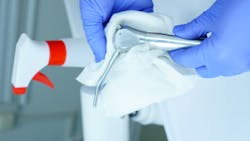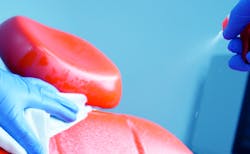Has COVID-19 taught you anything?
QUESTION: In recent weeks, I have seen recommendations about what dentists should do relative to post-COVID-19 infection control from various sources, including politicians, public health officials, practicing dentists, nonpracticing academics, and many others. The suggestions range from realistic to absurd. Where are practitioners relative to these suggestions as we return to our practices in the middle of the COVID-19 pandemic? What should we be doing? If we integrate those many complex infection control procedures into our practices, can we still produce enough dentistry to support our staff and our families?
ANSWER: I agree completely with you that today’s confounded information relative to infection control guidelines is confusing and highly contradictory. It seems that almost every day some new suggestion comes out that is contrary to previous suggestions or mandates. COVID-19 is still here and estimates state that it will linger for a long time. Some of the guidelines, suggestions, and mandates proposed by the previously named organizations are unrealistic and clearly show the lack of experience they have had with actual clinical practice and previous pandemics.
My answer to your question will be based on several decades of research accomplished in the TRAC division of Clinicians Report Foundation led by Rella Christensen, PhD, and her team. It also includes my own personal observations as well as those from Clinicians Report clinical evaluators, whose combined experience equals hundreds of practice years.
The following information will provide realistic guidance for you, but it may frustrate the idealists and those who have not had practice experience in real-world situations.
Office cleanliness
This is one aspect of infection control that is relatively simple. Someone in your office can be assigned to oversee infection control and office cleanliness, but it is a mandatory team effort. What are the responsibilities for this person? To be constantly looking at office cleanliness and stimulating your team to also do so is one of them. Since many patients are treated each day in a typical office, the chance for diseases to come into your office is constantly present. The bathrooms need cleaning several times per day. The doorknobs, toilet handles, reception room, front-desk counters, magazines, and any other items touched by patients need cleaning and reorganization during the clinical day. Operatories need routine observation and cleaning of debris on the floor, the walls, the operating lights, the ceiling, and any other areas that accumulate debris during the day. This person can also oversee the infection control products used by the office and ensure the presence of adequate surplus items for future emergencies such as COVID-19. Frequent in-service sessions on infection control should be planned and administered by this person.
First, this is impossible. Dental offices, like all outpatient medical clinics, have many healthy and some ill patients coming in every day. The infection control goal should be to reduce, to the highest level achievable, the possibility of patient cross-contamination. What are the levels of potential disease control in the dental office?
Sterilization is accomplished on those items that can be placed into a sterilizer, such as hand instruments, handpieces, syringes, burs, etc. However, only a few items used for treatment and preventive procedures can be sterilized, which, as you know, means killing of all bacteria and deactivation of all viruses. There is little if any cross-contamination hazard remaining on those items after sterilization, but many items cannot be sterilized.
Disinfection of items increases the chance of cross-contamination relative to sterilization, but it is better than nothing at all. As you know, disinfection only reduces the number of microorganisms. A few of the items used routinely that cannot be sterilized for various reasons are usually only disinfected, leaving a moderate chance for cross-contamination. They include:
• Curing lights
• Scanners
• Computer keyboards
• Computer screens
• Suction hoses
• Saliva ejector hoses
• Storage drawer handles
• Soap containers
• Paper towel holders
• Cameras
• Telephones
• Bottle tops such as on bonding agents, liners, cements, medications
• Patient mirrors
• Impression syringes
• Finished impressions
I ask you to look at this list and other items you can identify. Can you truthfully say those items receive disinfection every time they are used? You and I know the answer.
Numerous items such as those listed below are infrequently disinfected and not sterilized. These items have a significant chance for cross-contamination:
• Contaminated air in your office
• Loupes
• Eyeglasses
• Pens and pencils
• Removable appliance polishing lathe pan
• Rag polishing wheels
• Laboratory countertops
• Front-desk countertops
• Bathroom sinks and countertops
• Ultrasonic cleaner
• Operating chair arms
• Monitor supportive arms
• Radiograph device support arms
• Radiograph control panels
• Intraoffice communication systems
So what?
I know you will agree with most of the examples I have listed above. Some of us have found ways to overcome a few of the challenges I have listed, but most of them will continue to be potential cross-contamination problems. Let’s be realistic: Sterility in an outpatient office is impossible. Should we just admit defeat and hope everything will be okay? No, I strongly feel that the COVID-19 pandemic has made all of us think creatively on how to reduce the infection control challenges in our offices.
The following are my suggestions for practicing dentists to reduce cross-contamination in their offices.
Sterilizers
Make sure your sterilizers are in good order by testing them routinely with sterilizer testing products. 3M is a leader in sterilizer testing and has recently placed on the market a revision of their previously available Attest sterilizer testing kit. Use such kits routinely.
Disinfection
We previously discussed items that are nearly impossible to disinfect without damaging them. For those items not damaged by disinfectants, use of high-level alcohol disinfectants is suggested. I suggest doing a surface test with your high-level alcohol disinfectant (such as BioSurf by Micrylium, over 80% ethyl alcohol by volume/70% by weight) on a nonvisible portion of the object to see if the disinfectant harms the surface. For those items that are potentially damaged, consider using barriers on them. Many practitioners are using adhering barriers such as relatively inexpensive plastic wrap. Be sure to remove the barrier by folding it onto the contaminated surface during removal and dispose of it appropriately. Regardless of what you do with this category, the risk of contamination is only reduced, not eliminated.
Elements and items almost impossible to disinfect
The air in your office is a major factor here. Your furniture, drapes, rugs, and countertops are obvious others. These items have cross-contamination risks. Since every dental office is different, I suggest having a staff meeting and deciding as a team the potential best ways to reduce this hazard. Every office staff will have different ideas. As an example, I highly suggest educating your staff about the use of proper techniques with high-volume evacuation (HVE) and other simple ways to reduce aerosol droplets by as much as 85% as shown by Clinicians Report Foundation research (cliniciansreport.org). I recommend that you don’t buy expensive air filtration systems until further research shows their desirability.
Some tangible items can be disinfected well with high-alcohol disinfectants, while others can be washed with soap and water. But, to do this routinely and effectively, the necessary disinfectants or soaps must be present in appropriate locations, such as bathrooms, to allow easy access to them on busy clinical days. Some of the items can only be covered with barriers as described above. Look over the CDC recommendations available on the internet and adapt them to your office in a realistic manner. Practical Clinical Courses video V2452, Infection Control for Every Practice, considers many concepts from a realistic standpoint and helps you to do infection control and still have time to practice.
The psychology of infection control
In my career, I have lived and practiced through several health situations such as COVID-19, but I will admit none of them has had the exaggerated, confounding, inaccurate, damaging, and overblown media and political emphasis as COVID-19. The psychological damage, especially to children and seniors, including depression, suicide, and other challenges caused by this confusion and anxiety may have more negative influence in years to come than the actual deaths caused by COVID-19.
Summary
COVID-19 has devastated the world both financially and from a health standpoint. Recovery will require many months or years. All practicing dentists have experienced significant financial and psychological challenges due to the pandemic. It is still here and will remain here for years. Listen to the long-term practice experiences of practitioners who have weathered similar pandemics. As with other pandemics, this too will pass!
Author’s note: The following educational materials from Practical Clinical Courses offer further resources on this topic for you and your staff.
New three-hour digital course featuring Rella Christensen, PhD:
Preparing for Your Return to Dental Practice in the New COVID-19 World (Item V2407)
One-hour video:
Infection Control for Every Practice (Item V2452). This video includes information directly related to Centers for Disease Control recommendations and how to implement them.
For more information about these educational products, please call (800) 223-6569 or visit our website at pccdental.com.
About the Author

Gordon J. Christensen, DDS, PhD, MSD
Gordon J. Christensen, DDS, PhD, MSD, is founder and CEO of Practical Clinical Courses and cofounder of Clinicians Report. His wife, Rella Christensen, PhD, is the cofounder. PCC is an international dental continuing education organization founded in 1981. Dr. Christensen is a practicing prosthodontist in Provo, Utah.

